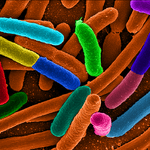Microbiology

Bacteria exposed to a common disinfectant called benzalkonium chloride may develop resistance to certain antibiotics as well as the disinfectant itself, according to research published in the January issue of Microbiology. The authors of the study say their findings could have important implications for how the spread of infection is managed in hospital settings.
Researchers from the National University of Ireland in Galway found that by adding increasing amounts of disinfectant to laboratory cultures of Pseudomonas aeruginosa, the bacteria could adapt to survive not only the disinfectant but…

Scientists have identified a strain of antibiotic-resistant tuberculosis that thrives in the presence of rifampin, a front-line drug in the treatment of tuberculosis. The bacterium was identified in a Chinese patient, and the researchers say his condition grew worse with treatment regimens containing rifampin, before being cured with rifampin-free regimens.
Their study, which will appear in the January 2010 issue of the International Journal of Tuberculosis and Lung Disease, is among the first to document the treatment of a patient with rifampin-dependent infection.
For the study, the…

This is a fascinating article about how behavior at different levels of organization show strong parallels.
“Humans in solitary confinement can go crazy, talking to themselves andtrying to break free. Now scientists from New Mexico and New Hampshireare reporting that bacteria locked in solitary confinement know theyare locked up, talk to themselves, and try to break free of theirimprisonment.”
Scientists trapped a single Staphylococcus aureus bacterium in a glass case essentially 20 micrometers wide, and watched to see what the organism would do when it “realized” was trapped.
We may have a…

With the publication of a new study in Cellular Microbiology, an international team of researchers has shed new light on the infection strategy of Salmonella, suggesting that scientists will have to reassess their understanding of how the pathogens invade host cells.
Although Salmonella are long-known pathogens, the precise mechanisms they use to infect are incompletely understood. The bacteria inject a protein cocktail into host cells using a molecular syringe, leading to dramatic rearrangements of cytoskeletal filaments below the cell membrane.
As a result, membrane waves called ruffles…

Bacteria are abundant in soil, water, and air as well as in the depths of the Earth's crust, organic matter, and live animals or plants. They are also abundantly social -- among themselves and with others. Not only do they interact with each other but also with their host. Bacillus subtilis and Streptomyces coelicolor are two examples from daily life. The former would be involved with the ropiness of spoiled bread. But the well-known Streptomyces produce the soil's earthy aroma and flavor and the majority of…

Slimeball… a derogative term to be sure, from the modern usage, but before it was ever dragged down to the world of insults and verbal nastiness we know it for today, the scum of which we speak and the small bacteria that form them were simply the catalysts for the many beautiful colours we see in hot springs.
While a whole host of thermophilic (heat-loving) microorganisms are responsible, it is the cyanobacteria, one of the more common fellows from this group, which form most of the scum. Cyanobacteria grow together in huge colonies (bacterial mats) that form the delightfully colourful scums…

Cooperation is seen in every corner of life from microbes to humans, many times with no obvious advantages to those that provide it at high costs. Given the existence of “freeloading cheaters” ready to exploit the resources of those cooperating, why is it that cooperation persist? In an article now published in the journal Current Biology Nogueira and colleagues suggest that in bacteria this can result from highly mobile genes that “jump” from one cell to the next carrying the cooperative traits, effectively turning everyone into a cooperator. They also show that, at least in Escherichia coli…

Researchers say they have discovered how to transform human embryonic stem cells into germ cells, the embryonic cells that ultimately give rise to sperm and eggs, an advance that will allow researchers to observe previously inaccessible human germ cells in laboratory dishes.
"This achievement opens a new window into what was only recently a hidden stage of human development," said Susan B. Shurin, M.D., acting director of the Eunice Kennedy Shriver National Institute of Child Health and Human Development (NICHD), the NIH Institute that provided funding for the study. "Laboratory observation…
Your Jack-o'-Lantern may scare away more than just birds - the skin of that pumpkin contains a substance that could put a scare into microbes that cause millions of cases of yeast infections in adults and infants each year, says a new study in the Journal of Agricultural and Food Chemistry.
Kyung-Soo Hahm, Yoonkyung Park and colleagues note that some disease-causing microbes are becoming resistant to existing antibiotics so scientists worldwide are searching for new antibiotics. Past studies had hinted that pumpkin, long used as folk medicine in some countries, might have antibiotic effects.…

For those who enjoyed our first set of bacteria art images, you will definitely want to check out Microbial Art.
www.microbialart.com